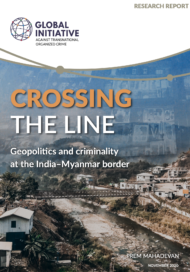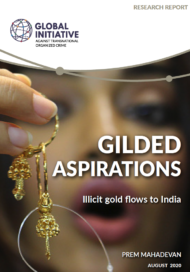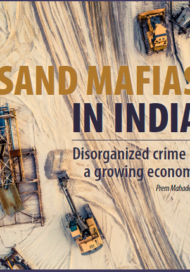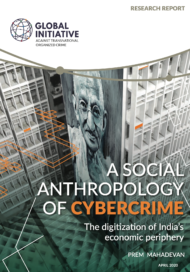Posted on 15 Dec 2022
The term ‘mafia’ is used in India to label the criminal actors behind some crimes – but not others. A more strategic use of the word could capture public discourse and drive policymakers’ attention towards more pervasive criminal markets.
With a population size set to exceed that of China in 2023, the world’s fifth largest economy, high income inequality and relatively weak state institutions, it is no surprise that India ranks highly for criminality and low for resilience on the Global Organized Crime Index. The criminality score is based on the diversity of organized illicit activities conducted within the country. But, of these, three criminal markets stand out in particular: human trafficking and smuggling, and fauna crimes. None gets focused attention from policymakers or the general public. One reason might be that they are seldom linked to one politically charged word – ‘mafia’.
In certain provinces of India, political factions and criminal gangs are seen, for all practical purposes, as conjoined twins. This makes it dangerous for journalists to openly use the term ‘mafia’ in their reporting, as that might expose instances of possible elite patronage at the local level of illicit actors. The Index finds that ‘state-embedded’ actors and ‘criminal networks’ are the most common types of organized crime entities in India, although the country scores better in this regard than five of its seven South Asian neighbours (the exceptions being Bhutan and the Maldives). There are also non-state networks engaged in illicit entrepreneurship, which take advantage of India’s lax regulatory environment in specific sectors. According to the Index, the country’s mafia-like syndicates are the least pervasive in South Asia.
While this might be explained at one level by the sheer size of India – which could prevent any one criminal entity from reaching the critical mass needed to dominate a local market – given the importance of family and clan networks in Indian society, it is still surprising, as such networks are often associated with mafia-like criminal actors. Another explanatory factor might be that the emergence of a tenuously sizeable middle class in the last 30 years has diminished the primacy of the traditional clan-based ‘joint family’ (multiple generations of a single family living in close physical proximity to each other and creating an exclusivist social network based on blood relations). Interpersonal ties forged through shared work experiences and caste backgrounds, rather than narrow kinship ties, provide the foundation for much present-day organized crime occurring in the country. This makes for more opportunistic and less cohesive underworld organizations than might be expected of a typical mafia. Entrenched crime dynasties, such as the Sicilian Cosa Nostra, are rare in India because few trading households have the financial capital and street muscle needed to exclude competitors from a territory. The exceptions would be entrepreneurs and gangsters who reportedly enjoy ties, in certain localities, to elected policymakers.
Not using the word ‘mafia’ to describe such actors means that coverage of organized crime fails to grip the attention of the Indian media. Those illicit markets that frequently feature the use of the term, such as ‘land mafia’, ‘mining mafia’ and ‘water mafia’, tend to be well covered by local journalists. But these markets, while they command the attention of the Indian middle class, are not distinctly represented in the Index. Instead, they are covered under the broad umbrella of resource and environmental crimes – categorizations that do not evoke the same strong sense of menace as ‘mafia-related’ crimes.
The term ‘mafia’ has a sinister quality in the popular imagination that bureaucratic jargon cannot capture. Human trafficking, human smuggling and fauna crimes are not routinely associated with this word. Terms such as ‘kidney mafia’ appear much more rarely in Indian media discourse than ‘sand mafia’ or ‘land mafia’, and ‘poaching mafia’ does not exist as a term. Instead, those people and animals that fall victim to organized crime are treated as incidental casualties of a booming economy.
Reframing the narrative
Under the Index, India scores poorly on the resilience indicator of victim and witness support because it does not recognize many forms of organized crime as having mafia-like characteristics. Some are considered the dark corners of economy building, and the harms done by them, while not condoned, are seen as a lesser evil than widespread poverty in a world where gross domestic product, currency stability and foreign exchange reserves determine national status. As a country fixated on regaining its status as a great civilization, India is focused on economic growth above all other considerations. Hence, it has underinvested in expanding and upgrading its law enforcement apparatus, seeing such costs as unproductive. The result is that in certain parts of the country, such as those prone to political conflict, police forces face a constant battle to stay on top of physical security threats to themselves.
Claiming that some regional-level and local political parties have mafia-like characteristics and that mafia organizations have political patrons would rejig the foundations of Indian democracy – an unpopular path. But dedicating more resources to police intelligence and investigative capacity would help address the sustained threat posed by different organized crime groups without labelling them all as ‘mafias’, each deserving a policy response. Another measure could be the introduction of lengthy prison sentencing norms for corrupt public servants, in particular, judicial officials found colluding with criminal economic actors. Finally, a backdrop of growing geopolitical tensions and state interventionism in market conditions is an opportunity for the Indian government to exercise greater regulatory control.
The Sicilian mafia was tamed (albeit not defeated) when it escalated criminal violence to a level that the Italian state could not ignore. Organized crime actors in India, whether local or transnational, are generally careful not to come to the attention of the central government in New Delhi, as that could mean a mobilization of national security infrastructure to weaken such actors. Other criminal groups, even if they traffic in arms, as is the case in parts of central India, do not openly confront state authority at a political level. But in weakening the rule of law, they indirectly undermine the legitimacy of government institutions.
Through a corrosive process, organized crime eats away at the strength of Indian statehood. Combating it requires tactfulness in not alienating the same political class and electorate whose support is essential to legitimize any state crackdown. But it also requires an understanding that such crime rises above being a mere corollary to economic development but rather poses an obstacle to the very goals that the policy elite in New Delhi aspires to: a prosperous and more equitable India.
This analysis is part of the GI-TOC’s series of articles delving into the results of the Global Organized Crime Index 2021. The series explores the Index’s findings and their effects on policymaking, anti-organized crime measures and analyses from a thematic or regional perspective.



